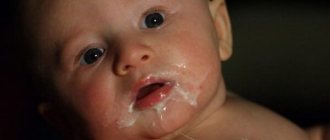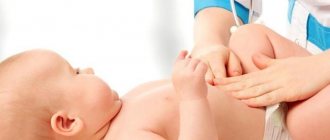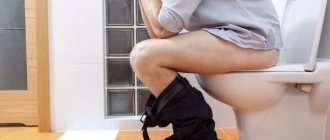Constipation in a 2 year old child: causes
Defecation disorders in babies are most often caused by improper diet of the baby or nursing mother.
Doctors identify the following causes of constipation in children 2 years of age:
- Insufficient fluid intake. This is one of the main sources of pathology.
- Intestinal dysbiosis. Often this disease is a consequence of illnesses suffered during pregnancy. May develop as a result of toxicosis or threat of miscarriage.
- Reduced intestinal motility. Pathology occurs in children who eat food that does not ensure the active functioning of the digestive tract. Such dishes include liquid porridges and chopped food.
- Physical inactivity, hypotension. Inactivity negatively affects all body systems. The digestive tract also suffers from it. As a result of low activity, the walls and muscles of the intestines can atrophy.
- Hypotrophy. Weak intestinal walls are unable to push through accumulated feces.
- Abundance of medicines. Often, constipation in a child (2 years old) is caused by uncontrolled use of medications aimed at improving the process of bowel movements or digestion.
- Worm infestations. A common cause of broken bowel movements.
- Diseases. Gastritis, diabetes mellitus, thyroid pathologies, and ulcers can lead to constipation. Cracks in the rectum or hemorrhoids can disrupt a child’s stool.
- Adverse drug reactions. The use of certain medications can lead to an unpleasant condition. Constipation occurs after taking medications: antihypertensives, antihistamines, antidepressants, codeine, diuretics, antibiotics.
If there is constant constipation in a child (2 years old), then it is very important to establish the true cause of this phenomenon. Often, a similar picture is typical for those babies whose parents suffer from defecation disorders. Therefore, a hereditary factor cannot be excluded.
Transferring the baby to artificial feeding can provoke a problem. Sometimes psychological constipation occurs in a 2-year-old child. After all, the baby is very susceptible to the influence of various factors. The basis of this condition may be weaning, the first visit to the nursery, refusal of diapers and potty training.
Let’s try to figure out what are the causes of defecation disorders and why they are relevant for children under 2 years of age, taking into account the important points and not missing out on the details.
Children who are constantly tormented by constipation experience severe pain, they are whiny, capricious, and the daily ritual of going to the potty turns into hysterics.
The main reasons are an unbalanced diet, an inactive lifestyle, and it can even be a problem at the psychological level.
But you can dig deeper and get a whole list of reasons.
- A reaction to medications, in most cases to antibiotics, which is why it is advisable to prescribe along with them drugs that restore intestinal microflora. The amount of medications the baby takes must be strictly controlled; there should not be too many of them;
- Irregular and insufficient fluid intake. Water is life, about a liter of water should be drunk by a 2 year old child. Just pure water, not compote, juice, broth, etc.;
- Decreased intestinal motility, a consequence of feeding a two-year-old child with crushed food. The normal and active functioning of the intestines is disrupted, and the child may be debilitated by constipation;
- Signs of stool disorders include diseases - gastritis, hemorrhoids, diabetes, and even worms;
- Hypotrophy - weakened intestinal walls are not able to push feces through;
- A common cause that occurs not at the level of the tummy, but at the level of the head is psychological constipation.
All reasons that can lead to stool retention are divided into 2 large groups - functional and organic. Functional reasons lead to disruption of intestinal function, but its structure does not change. Organic causes may be due to structural abnormalities, inflammation, infection, or neoplasm.
With functional constipation, the nervous or humoral regulation of intestinal activity is disrupted. This condition can be caused by a number of reasons - nutritional, psychological and physiological.
Organic causes are not limited to the gastrointestinal tract. Often constipation is a symptom of a disease in another system. For example, stool retention is a common symptom of congenital hypothyroidism (decreased thyroid function) and rickets.
Intestinal abnormalities
They can be either acquired - adhesions, tumors, polyps, or congenital - innervation of the colon or elongation of the sigmoid process. Although the latter, as a rule, are already identified and cured by the age of two, as they manifest themselves quite acutely.
Reasons for its development
Dr. Komarovsky says the following about constipation in children: “The main reasons for difficult passage of feces is the lack of fluid and potassium in the growing body.”
During dehydration, stool becomes dry and makes bowel movements difficult . A lack of potassium in a growing body (especially in the first years of life) negatively affects the wave-like contraction of hollow tubular organs and prevents the movement of their contents into the outlet openings. This phenomenon makes it difficult to pass feces.
Significant reasons for concern
According to the medical reference book, constipation is difficult or delayed bowel movement. The degree of importance of the problem and options for treatment and assistance are largely determined by the age of the child.
We note right away that Hirschsprung’s disease may be a significant cause for concern; in this case, urgent and emergency care is important.
The disease is detected mainly in the first year of a baby’s life. The disease implies a lack of development of nerve cells in parts of the intestines and this is a consequence of constipation in children. Treatment is exclusively surgical and urgent; without surgery, the child is doomed. This disease is rare (1 case per 3-5 thousand babies born).
Therefore, if a healthy two year old child is suffering from constipation, the chances of any congenital abnormalities are low, but always remain a vigilant parent and seek help from a doctor. Only he can identify the cause.
Constipation is not a disease, it is a temporary nuisance that signals a symptom of a real disease (cholecystitis,
pancreatitis
, hemorrhoids, etc.)
Types of constipation
Signs of constipation in a baby vary depending on the structure of stool retention. There are the following types of defecation disorders:
- Physiological - motility is not impaired, but the difficulty in emptying is caused by the fact that dry, dense feces have difficulty moving through the intestines.
- Atonic - due to impaired innervation of the intestinal wall or decreased smooth muscle tone, motility is inhibited.
- Spastic - hypertonicity of the intestinal muscles, caused by a disorder of innervation or spastic readiness of smooth muscles, gives the following symptoms: stool retention, abdominal pain.
Alarming symptoms
Symptoms of constipation are easy to identify; the main thing is to monitor your child’s routine and the interval between which the process of bowel movements occurs. There is no reason to panic if the child is cheerful, cheerful, eats well, but does not walk around every day.
Everyone’s body is different, some children poop 3 times a day, and others 3 times a week; in pediatrics, this is the norm if a healthy child does not go to the toilet often.
https://www.youtube.com/watch?v=QEIKhuq_Jiw
If there is no bowel movement for more than a day, but the following accompanying symptoms appear, then we may be talking about constipation:
- Poor appetite;
- Abdominal pain;
- Nausea;
- The amount of feces is small, has a dense and hard consistency, causes pain;
- Restless sleep;
- The child cries, is capricious;
- Lethargy and decreased activity of the baby;
These symptoms should be a signal for you to help your little one, since feces accumulated in the body, secreting
toxic gases
, inhibit the normal functioning of the gastrointestinal tract.
You should take seriously the constant constipation that occurs in children and such symptoms that will cause you to call emergency services.
- Vomit;
- Increased body temperature;
- Pain in the tummy is accompanied by “gurgling”;
- Blood in stool;
- Discharge of loose stool due to constipation;
- Pronounced pallor of the skin;
Constipation in children under two years of age is mostly just a fleeting nuisance, but frequent problems with bowel movements, accompanied by the above symptoms, can be a sign of serious diseases associated with the gastrointestinal tract and various types of intestinal obstruction.
- Your baby should have bowel movements at least six times a week
- Complaints of abdominal pain. If the baby cannot speak yet, he cries and worries
- The act of defecation itself is accompanied by strong straining; you see that this process causes severe discomfort to the child
- The nature of the stool is atypical: either too dry and comes out in small fragments, or has a too dense structure
- The intestines are not completely emptied.
The presence of all these symptoms indicates that the baby has defecation problems. And if such symptoms do not go away for three months or more, the child has chronic constipation.
The main symptom of the disease is bowel movements less than 6 times a week. In this case, defecation is accompanied by difficulty, it is necessary to use additional manipulations.
With chronic constipation, symptoms of intoxication may develop - the child becomes lethargic, drowsy, does not want to play, and refuses food. With acute constipation, a child may have severe stomach pain - he screams, cries, squirms.
A two-year-old child should have a bowel movement daily. However, you should not panic if this does not happen. Doctors recommend monitoring the baby. If a child is in a great mood, he plays, laughs, and when it’s time to eat, he completely empties the plate, then should we suspect constipation? Having eaten, the baby falls asleep soundly and wakes up in a great mood.
Pediatricians say that in such a situation, even if the baby has not had a bowel movement for the second day, there is no reason to panic. Each baby has its own rhythm. Therefore, you should initially focus on the child’s well-being.
The following standard has been adopted in pediatrics. The process of defecation can occur from 3 times a day to 3 times a week. In this case, the baby does not experience discomfort, and bowel movements occur easily. This is a physiological norm.
How to determine constipation in a 2 year old child?
The following symptoms indicate a problem:
- absence of bowel movements for 1 day (when combined with other symptoms);
- weakness, lethargy;
- decreased appetite;
- feces have a dense consistency;
- abdominal pain;
- disturbed sleep;
- bloating;
- small amount of feces;
- anxiety, crying;
- stool streaked with blood;
- nausea.
It should be understood that there are situations when a child’s constipation (he is 2 years old or younger is not so important) requires emergency medical help.
Symptoms accompanying constipation require immediate consultation with a doctor:
- Hyperthermia. A common cold cannot be ruled out. However, an increase in temperature can be caused by fecal intoxication. Only a doctor can determine the true cause of hyperthermia.
- Vomit. This is one of the signs of increasing intoxication. In addition, it is dangerous due to rapid dehydration of the body.
- Streaks of blood. They may indicate hemorrhoids, fissures or other pathologies. Only a physician can correctly diagnose pathology.
- Abdominal pain is accompanied by a characteristic “gurgling” sound.
- Loose stool leaks through constipation.
Retention of stool in infants is normal
Each baby has a different frequency of bowel movements, which depends on many factors. And here it is important to remember this:
“In infants, rare bowel movements almost always indicate that the food the child eats is of high quality, suits him perfectly and is almost completely absorbed,” says Evgeny Komarovsky. – And if the baby is fed breast milk or an adapted formula, if you introduce the correct complementary foods on time, but the baby does not poop for up to six days in a row, this is normal. Provided, of course, that this does not cause him discomfort and does not affect his well-being and development.
That is why most often the problem is not in the child, but in his environment.
“Grandmothers, having learned that the baby has not gone to the potty for two days, immediately begin to lament about this, advising to “treat” him with folk methods, and mothers worry and look longingly at the empty potty,” says Evgeniy Olegovich. – In this case, the cause of stool retention may be, for example, excessive mother’s care. Judge for yourself. Let's say mom has two potatoes. She can boil them in their uniforms and give them to the child, and he will absorb 80% of this dish, the rest will come out naturally. Or mom can boil them, peel them, mash them properly, add milk and butter. The result will be a liquid puree that will be absorbed almost entirely. There is simply nothing to leave the body!
How dangerous is the pathology?
Parents just need to know, if their child (2 years old) is constipated, what to do in this situation. Because such a problem can provoke quite negative consequences.
The accumulation of stool in the body can lead to:
- circulatory disorders;
- intoxication of the body;
- intestinal fissures and hemorrhoids;
- lack of nutrients, which results in decreased immunity and anemia;
- inflammation of the mucous membrane;
- increased gas formation;
- development of a neurological problem (the baby begins to fear the process of defecation);
- intestinal obstruction;
- bowel cancer.
Types of difficult bowel movements in infants
Based on the duration, constipation is also divided into two types:
- Acute constipation. A sharp retention of a child’s stool, which is due to a specific reason and can be eliminated with proper and timely treatment.
- Chronic constipation. This type of disease is characterized by rather prolonged difficulties with bowel movements. Systematic constipation over a long period of time is a manifestation of certain problems in the baby’s body or untimely treatment of acute constipation. As a rule, treatment of a chronic type of defecation disorder also involves long-term therapy.
What is psychological constipation?
Little people are very sensitive to life factors that are unpleasant for them.
There are many reasons:
- weaning from breast or bottle;
- weaning off pacifiers or diapers;
- doctor visits;
- reluctance to go to kindergarten.
All this can become a very common reason for violations of “going to the potty.”
A fairly common occurrence may be a rejection of the place where the process of defecation should take place, the baby does not like the potty or toilet, the smells and temperature in it.
When potty training, organize this ritual correctly, scolding or blaming the baby for soiled laundry, you risk failure. The baby remembers that he can be scolded for wrong actions and withdraws - such a negative experience is a frequent phenomenon that lies on the conscience of the parents.
When you need a doctor immediately
Delayed disposal of feces has a negative impact on health. Appetite worsens, digestion processes are disrupted, the number of pathogens increases, and an imbalance of microflora develops. The body is less well supplied with vitamins and microelements, and the level of hemoglobin decreases.
Some symptoms should especially alert parents. Sudden constipation may conceal intestinal obstruction or intussusception. Such conditions require immediate medical attention.
Contact your doctor immediately if you notice the following symptoms in your child:
- constipation was accompanied by nausea, vomiting and fever
- There are blood clots in the stool
- the baby is very restless, whiny and refuses to eat
- severe weakness appeared in the legs, even to the point of falling
- symmetry of the buttocks disappeared
If any manifestations are unusual and alarming, it is better to consult a pediatrician. Remember that taking a laxative or giving an enema to a child with an intestinal obstruction is life-threatening.
Diagnostic methods
So, if you suspect constipation in a child (2 years old), what to do in this situation? The best decision is to seek help from a pediatrician. After all, the source of this problem can be a variety of pathologies. Without diagnostics, it is extremely difficult to identify diseases.
In addition, individual therapy is selected for the treatment of the child. Only a doctor can adequately take into account all factors: the causes of the disease, the severity of the condition, age, concomitant diseases, and the psychological characteristics of the baby.
Main directions of therapy:
- dietary nutrition;
- drinking regime;
- gymnastics;
- drug treatment.
You should not resort to drug therapy on your own. Only a doctor can recommend the medications necessary for the baby. Parents should be aware that frequent use of laxatives (especially without first consulting a doctor) can lead to the development of unpleasant symptoms, such as frustration and allergic reactions. In addition, the child may become accustomed to the use of such products.
Therefore, asking the question: “How to treat constipation in a 2-year-old child?” Parents owe only to the attending doctor.
As a rule, doctors prescribe complex therapy:
- Laxative medications. Children may be prescribed medications: Duphalac (syrup), glycerin suppositories, sea buckthorn suppositories.
- Prokinetics. Often, medications such as Motilium and Domperidone are recommended for babies.
- Enzymes. To improve the digestive process, medications “Mezim”, “Panzinorm”, “Creon” can be prescribed.
- Probiotics. To restore the microflora in the child’s body, the doctor will recommend the drugs “Bifidumbacterin”, “Acipol”, “Hilak Forte”, “Linex”.
However, it is extremely important not to resort to such therapy without a doctor’s prescription.
If you experience frequent constipation, you should definitely contact your pediatrician. The doctor will examine the child and, if necessary, prescribe additional examinations - stool analysis, X-ray examination of the intestines. During a physical examination, the doctor palpates the abdomen, examines the anal area, and checks the anal reflex.
Treatment is not limited to just one treatment method; an integrated approach is used. For functional constipation, diet therapy, active games, massage, formation of a bowel movement regime, and psychological work with the child are used. If non-drug treatment does not help, the child can be treated with home remedies and laxatives (strictly under the supervision of a doctor).
In about half of the cases, intestinal function can be normalized without the use of medications; for this you need to adjust the baby’s lifestyle. What you can do at home:
- Give your child more to drink. Lack of fluid often leads to difficulty defecating. How much water to give per day depends on your weight - 50 ml of water per 1 kg of weight.
- Form a bowel movement routine for your baby. Organize a comfortable and convenient toilet, do not allow negative emotions during the act of defecation. Teach your baby to have bowel movements at the same time.
- Avoid the morning rush; the child should have breakfast slowly.
- Atonic constipation is common in children, so they need to maintain an active lifestyle. Spend more time outside, play active games, limit your time watching TV.
- Reflex stimulation will help get rid of symptoms - before eating, do a light abdominal massage in a clockwise direction for 5 minutes.
To normalize intestinal function, you need to eat right. For a child aged 2 years, it is recommended to eat split meals 6 times a day - 3 main meals and 2 snacks.
What foods have a positive effect on intestinal health:
- Containing fiber: fresh vegetables and fruits, berries, herbs, bran, rye bread.
- Fermented milk products that improve intestinal motility and prevent dysbiosis: kefir, yogurt, yogurt without additives.
- Sources of potassium: prunes, figs, raisins, dried apricots.
- Oatmeal and buckwheat porridge.
It is necessary to limit the consumption of foods that inhibit bowel emptying - strong broths, semolina porridge, jelly, puree soups. Chocolate, baked goods, and smoked foods should be completely excluded from the diet.
To treat constipation in children, it is important to adjust nutrition and ensure a favorable psychological climate.
If non-drug treatment is ineffective, medications that have a laxative effect can be used.
They should be used carefully, as side effects may develop - addiction, dehydration, allergic reactions. Before using laxatives, you should definitely consult your pediatrician and carefully follow the instructions.
What laxatives can be used in children aged 2 years:
- Oils that have a softening effect are castor, vaseline, sea buckthorn. They can be given orally or administered rectally as suppositories.
- Herbal laxatives. These are mild laxatives that contain senna leaves or rhubarb root - Senade, Senadexin.
- Prebiotics with a mild laxative effect (based on Lactulose).
Folk remedies
Often, folk recipes based on medicinal herbs or food are used to treat constipation.
How to treat frequent constipation in a 2-year-old child? First of all, it is necessary to establish the correct diet and drinking regime.
A diet for constipation in a 2-year-old child should be laxative in nature, and experts recommend that the whole family adhere to it to make it easier for the child to adapt. Here's what to feed a 2-year-old child with constipation:
- Eliminate foods that make you feel strong: rice, pasta, unpeeled apples and bananas
- Do not overuse foods that cause gases to form in the intestines: cabbage, mushrooms, legumes
- Foods that reduce peristalsis are also prohibited: chocolate, tea, cocoa, jelly, blueberries.
- In case of constipation in a child aged 2 years, fermented milk products must be included in the diet: kefir, yogurt without additives, yogurt
- Sufficient consumption of pure water without additives is mandatory
- For constipation in a child aged 2 years, foods rich in fiber are included in the menu. This is necessary for sufficient formation of feces and restoration of normal peristalsis. Such products primarily include cereals, fruits, and fresh vegetables. Bread must be whole grain, baked goods are prohibited.
- Butter, lean meat, chicken eggs are allowed
Enema
An enema for a 2-year-old child with constipation is made from a glass of cool boiled water with the addition of a couple of teaspoons of glycerin. In order not to injure the baby, the procedure must be carried out with caution; be sure to disinfect the tip and lubricate it with oil or baby cream. Enemas are suitable only for one-time cleansing; their constant use can lead to chronic defecation disorders.
You can find out how to give an enema for constipation at home on our website.
Pharmacology
Drug therapy
The type of constipation in children affects the choice of treatment tactics. With spastic constipation, it is necessary to eliminate the spasm that has appeared, and with physiological constipation or atony, it is necessary to soften dense feces and strengthen motility. If you think an intestinal spasm has occurred, avoid methods that irritate the anus and rectum.
What should I give my child for constipation at 3 years old? If you decide to treat your baby's constipation with medications, consult your doctor first. Not all medications are safe for children. Without your doctor's permission you can use:
- Glycerin suppositories. Glycerin lubricates the intestinal walls, is not absorbed through the intestinal mucosa, makes stool soft and stimulates motility.
- "Duphalac". This drug is a probiotic, softens stool, stimulates peristalsis, and restores intestinal microflora.
- Microclysters “Microlax”. Sold in pharmacies in bottles with a dispenser. After insertion into the rectum, the stool softens and stimulates motility.
Warning symptoms and assistance
If the baby’s bowel movements are unsuccessful, then the parents should help the baby. One effective method is the use of glycerin suppositories. They are considered completely safe for babies. In addition, they are allowed to be used even for one-year-old children.
Another excellent method that can quickly help is a cleansing enema for a child (2 years old). For constipation, it is recommended to add a little glycerin to a glass of boiled cool water.
In order not to cause pain to the baby or harm his health, this procedure should be performed correctly.
The following tips will make administering an enema as easy as possible:
- The tip must be lubricated with oil or cream.
- The pear must be disinfected.
- Warm water should not be used. Such liquid will quickly be absorbed into the intestines and pull toxins with it. Doctors strongly recommend using cool water. The temperature of the liquid should be slightly below room temperature.
- Be sure to control the volume of fluid that is poured into the child’s body. Large amounts of water can cause intestinal distension. This will cause pain to the baby. Doctors advise infants 1-2 years old to administer 200-250 ml of water. For children from 2 years old to 6 years old, the volume of liquid increases to 300 ml.
However, this method should not be abused. Parents should understand that giving an enema provides a temporary laxative effect. Only a doctor can prescribe treatment for constipation in a 2-year-old child. Therefore, after this procedure, the baby should definitely be shown to a pediatrician.
This is a great procedure. However, it can bring a beneficial effect if the pathology is not in an advanced state. This treatment of constipation in a 2-year-old child promotes easier movement of food through the digestive tract and activates intestinal function.
The massage is quite easy. It is recommended to lightly stroke the baby's tummy in a clockwise direction in a circular motion.
Description of species
Few people know how to treat constipation in children aged 3 years. It is known that this disease most often occurs in infants, primary schoolchildren and preschool children. The reasons for obstructed bowel movements are varied, but stool retention always causes discomfort in the baby and is accompanied by indigestion.
Constipation in a 3-year-old child can be caused by many factors, both dangerous and not so dangerous. But in both cases, treatment is mandatory. Only a doctor can choose the right therapy, and low-quality self-medication can only aggravate the problem, causing many complications.
Before you try to cope with your baby's constipation on your own, learn the causes and signs of bowel dysfunction.
With the physiological type of constipation, stool retention is provoked by:
- physical inactivity;
- insufficient fluid intake;
- abuse of foods with low fiber content (baked goods, protein foods);
- irregular meals and fasting.
Here, physiological retention of stool can be prevented by analyzing the baby’s lifestyle and nutrition.
With the atonic type of constipation, the child develops the following symptoms:
- increased gas formation;
- heaviness in the stomach;
- pain during bowel movements;
- feeling of fullness.
With atony, feces accumulate in large quantities in the lower part of the rectum. When trying to go to the toilet, the baby often complains of pain and cries. Physiological and atonic forms of constipation are identical in manifestations. Intestinal atony is diagnosed by a pediatric gastroenterologist after an examination.
With the spastic type of constipation, the baby experiences muscle spasm under the influence of external factors (unfavorable living conditions, stress). After eliminating the provoking cause, the symptoms disappear on their own. What treatment is needed for spastic constipation in a 3-year-old child? Here, when emptying, rough, dense feces are released, similar to sheep's feces. If your child has constipation accompanied by intestinal colic, do not give a cool water enema. After all, this will provoke a more powerful muscle spasm.
Treatment for constipation can be long-term. The recovery process can last up to two years. After all, it will be necessary not only to restore intestinal activity, but also to eliminate the psychological barrier. The child does not always understand that going to the toilet brings relief.
How to deal with constipation?
The most important conditions affecting the normal, uninterrupted functioning of the intestines are:
- Replenishing the body with sufficient fluid;
- Providing him with a sufficient amount of potassium;
By losing, but not replacing, a large amount of water and salts, the work of intestinal juices slows down, intestinal contractions lose activity, resulting in constipation. A large amount of liquid and foods rich in potassium will help normalize stool: prunes, raisins, dried apricots. It’s not for nothing that dried fruit compote is so popular among kids.
A balanced and proper diet for two-year-old children should include foods containing fiber: all non-allergic vegetables and fruits, grains and legumes.
Children's diet should be limited to foods containing protein:
- chocolate;
- milk;
- nuts;
- butter;
- dairy products.
This is talking about primary and preventive care, but regarding medication and how to treat it, trust your pediatrician in this matter and do not self-medicate.
But for general development, know that the most ideal and safe remedy for constipation is lactulose (drugs Duphalac, Lizalak, etc.), it has no contraindications for age, so it is perfect for two-year-old children.
Constipation can be cured if you approach this problem comprehensively, as with any disease. Consultation is necessary and can be obtained not only from a pediatrician, but from specialized specialists who will prescribe examinations or appropriate tests. And the list of medications will not be limited to lactulose alone; other remedies for constipation are mostly well known to everyone: glycerin suppositories, laxatives, probiotics and enzymes.
An enema for a child with constipation can also help, but sometimes the children themselves do not take it. Not only the baby, but also the mother performing it should be prepared for this procedure. The water for the enema should be boiled and at room temperature, you will also need an Esmarch mug, a pear and Vaseline.
Be sure to explain to the child what you will do, do not rush and do not panic:
- The child should lie on his side with his knees bent to his chest;
- Gently insert the tip of Esmarch's mug, lubricated with Vaseline, into the baby's anus;
- Introduce approximately 50-100 ml of liquid inside, after a while ask the child to go to the potty;
Reasons why you should switch to mixed feeding
Mixed feeding is usually not a desire of young mothers, but a necessity that arises when breast milk becomes less and the baby needs to be nourished with something. Today there is active propaganda regarding the combination of formula and mother's milk. As for completely switching to artificial feeding, there is definitely nothing useful here.
For what reasons is it necessary to switch to mixed feeding:
- Reduced lactation in the mother.
- Situations in which the mother goes to work or other circumstances in which it is not possible to breastfeed the child.
- Illness of the mother during which she is unable to fully feed her child with breast milk.
- Breast milk does not have all the components a baby needs. This deficiency can be determined by indicators. If a child up to six months “hangs” on the chest for a long time. Also, when the child is very calm, the stool has a dense consistency and takes on a greenish color, which is not at all similar to the stool of infants. The urine begins to smell strongly, and the child pees much less often. Also another main symptom is poor weight gain.
After a month of life, a child should gain weight of no less than five hundred grams.
Diet food
Proper nutrition plays one of the most important roles in treating constipation. It is impossible to eliminate broken stools without following a diet. So, what should you give your 2 year old child for constipation?
Doctors give the following recommendations:
- Vegetable and fruit purees are preferred. Such products are rich in acids and fiber. They perfectly improve intestinal motility. Older children can be given vegetables and fruits as usual, or stewed or boiled. Healthy: carrots, beets, cabbage, pumpkin, zucchini, plums.
- The child should eat the fruit with the peel. After all, it contains a large number of essential substances.
- Salads should be seasoned with vegetable oil. Absolutely not suitable: sour cream, fatty sauces and mayonnaise. Such products lead to intestinal cessation.
- Fermented milk products will provide a beneficial effect. Especially useful for constipation: kefir, yogurt, fermented baked milk.
- The child should drink plenty of fluids. Fruit drinks, plain water, compotes, and juices are included in the diet.
- Porridges made from whole grains are good for your baby: buckwheat, millet, corn, wheat.
- To stimulate intestinal permeability, it is recommended to consume bran and whole grain bread.
- You should not give your baby fried or fatty foods. Onions, smoked meats, garlic, white bread, and radishes are prohibited. It is advisable to limit the intake of pasta, potatoes, semolina, and rice porridge.
Diet for constipation
Diet therapy for diarrhea will be aimed at excluding protein-rich foods from the child’s diet.
You can give your baby one-day kefir, black bread (and it is better to limit or remove white bread), yogurt, apple juice, and yogurt.
By drinking yogurt before bed and eating steamed prunes, you can eliminate constipation in 1 out of 4 cases, without using other medications. Komarovsky also emphasizes that there are no products that are categorically not recommended and must be used for constipation. The approach should always be individual.
Physiotherapy
If a child (2 years old) is constipated, it is important to provide the child with physical mobility. At the same time, the baby should be actively moving throughout the day.
Simple exercises can improve intestinal motility:
- squats;
- bends;
- bending the knees to the tummy;
- swing legs (straight and bent);
- press development.
Such gymnastics can be turned into an outdoor game. Kids especially like this. For example, instead of the usual squats or bends, you can ask the baby to collect buttons scattered on the floor. At the same time, set the condition that you should bring one piece at a time.
Folk recipes
Simple, time-tested methods can help if constipation is observed in children 2 years old. Folk remedies have a fairly effective and gentle effect on the child’s body. However, when selecting the necessary funds, intestinal tone should be taken into account. Therefore, it is best to discuss the use of traditional recipes with your doctor.
For spastic constipation accompanied by bloating, chamomile infusion will help greatly. In case of atony, the doctor will recommend brewing yarrow and nettle. Berries will provide an excellent effect: lingonberries, gooseberries.
The following folk recipes are popular and effective:
- Prunes introduced into the baby's diet perfectly eliminate constipation. It is used in the form of puree or juice. However, the latter should be given to the baby only in a diluted form (1:1).
- Bran is an excellent stool softener. It is recommended to add them to yogurt and cereals.
- Carrot juice will have a beneficial effect. It is recommended to give only freshly squeezed drink. For it to be beneficial, you need to drink the juice before meals.
- Cucumber puree will help cope with the unpleasant condition. It is also recommended to take it before meals.
- Allows you to correct stool in children, another effective remedy. To make it, you need to take caraway seeds, chamomile flowers and dill seeds in the following ratio: 2:1:1. This composition will require 1 tbsp. spoon. It is poured with boiling water - 0.5 liters. The composition should be infused for 2 hours. It is recommended to take this remedy in the amount of 1 teaspoon three times a day, 15 minutes before meals.
- Flaxseed oil will be beneficial. It can be consumed on an empty stomach with a small spoon. Another remedy is quite effective. It is recommended to mix equal amounts of honey and flaxseed oil. This mixture should be mixed thoroughly. This medicine is added to natural yogurt. The baby should drink it before bed.











